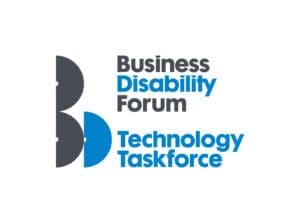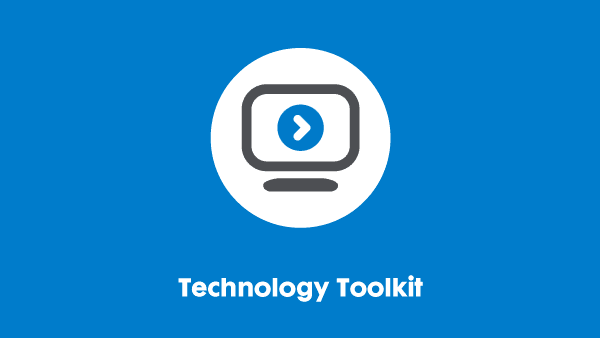Last updated: 4 August 2025
Supporting staff with assistive technology
This resource was created by our Technology Taskforce, a group of senior IT accessibility individuals from leading UK and global organisations. For more information, including how to join, see our website.

Introduction
What is assistive technology?
Assistive Technology (AT) can refer to any kind of device, software or system that helps people with disabilities perform tasks with greater confidence, accuracy and independence.
We have created a detailed guide to AT – ‘Assistive technology catalogues’ – which explains how organisations should approach AT provision and what options are available.
Why should businesses invest in assistive technology?
In the workplace, AT embraces solutions that give assistance to employees with a range of physical or cognitive disabilities – whether it’s dyslexia, visual/auditory impairments or difficulties using a computer keyboard and mouse.
Investing in AT can be a very smart decision for corporate companies and public sector bodies alike by:
- Creating the opportunity for employees to achieve their potential, be more productive and become more engaged.
- Broadening the recruitment pool to embrace a wider, more diverse range of talent.
- Minimising the legal, reputation, and efficiency risks of not making job roles available to people with certain disabilities.
- Sharing the benefit of an adjustment considered for one employee with a specific requirement with a larger number of employees with a wide range of needs.
What is the right AT solution for my organisation?
There are lots of AT solutions out there, from no-frills screen readers to powerful multi-function productivity suites. But which is the right one for your own organisation? And what’s the best way to implement it for maximum returns on any size of AT budget?
We’ve created a list of top tips to help you choose – whether you’re just hunting for some software to make everyday tasks easier for staff, or defining and implementing a complete AT strategy. This list comes from our experience as members of Business Disability Forum’s Technology Taskforce.
This short guide offers an illustration of what best practice might look like in your own organisation. Equally, you may well want to fine-tune our recommendations to accommodate your own particular circumstances.
You won’t find detailed technical information on specific technologies or implementation methods here. This checklist is intended purely to outline some the questions that can be applied in any industry and any technology.
For detailed guidance on the AT available, refer to our resource ‘Assistive technology catalogues.’
Assistive technology – Top tips
Have an assistive technology strategy
There’s a bewildering choice of AT solutions out there. The pressures of making the right choice can lead to inertia, with organisations deferring their investment indefinitely rather than risking the ‘wrong’ decision.
Equally, this can have the opposite effect, with rushed purchasing decision prompted by panic and indecision.
Take your time. Implement any AT strategy with confidence – rather than making knee-jerk decisions you’ll regret for years to come.
Provide flexible assistive technology solutions
It might seem self evident, but every organisation – and every staff member – is unique.
When you’re choosing an AT solution, make sure it has the flexibility and personalisation features to suit everyone who stands to benefit from it.
Provide portable assistive technology solutions
Portability of software and services is an increasing priority for many organisations.
Cloud-based AT solutions have obvious appeal in corporate environments, where staff are just as likely to be working at home or on the move as they are in the office.
Staff might well be using PCs and Macs, laptops, Chromebooks, tablets and smartphones – or a mixture of all of them. Your choice of AT software should be accessible on any device. And with many organisations implementing BYOD (Bring Your Own Device) strategies, be prepared for staff turning up with unfamiliar hardware that you’ll need to support.
Look at different models of assistive technology purchasing
Increasingly, software provision has moved away from upfront purchases to a subscription-based model, often referred to as ‘Software as a Service’ (SaaS). Providers of AT software may operate on either model.
Organisations should think about which model better suits their needs and incorporate that approach into their AT policy.
Continuous delivery offers organisations an attractive AT purchasing model. But it may conflict with IT policies at organisations that block unmanaged network-wide updates.
So, you’ll need to check whether a software provider is in sync with your own needs. Are you ready to go SaaS? Or will you rely on a vendor who can guarantee rock-solid support for all your current and legacy installs?
Remember – this is all about the user
Ultimately, it’s your employees’ real-world needs that matter. Challenge any potential AT provider to demonstrate whether they’re receptive to user feedback. Don’t be afraid to spell out your own organisation’s needs in detail, to ensure they’ll add it to their development roadmap.
Test software updates before rolling out
Organisations will have different policies on managing software updates and upgrades.
Many will take the easy management option of automatic updates, bug fixes and version upgrades. However, automatic updates do not allow for testing first, so there may be a knock-on effect, such as AT no longer working properly after an update. Some organisations – secure government departments for example – may not permit automatic updates.
Organisations may also need to keep their IT systems and software up-to-date for issues such as compatibility, security and performance. When thinking about AT software, you will need to test updates to ensure they remain compatible and work as expected. There is also a requirement from the AT publisher to ensure that their latest version is developed with ‘backwards compatibility’ in mind, so that it works with previous versions. In some organisations, not all devices running assistive software will have an internet connection, so offline updates will have to be managed.
When applying updates, it is cheaper in the long-run to test software updates will still work with your AT, rather than rolling out updates automatically and having to do remedial work afterwards. The more rework required, the slower and more costly the fix – and you can’t recover the reputational impact. The key thing is to ensure those who need AT have a smooth installation and uninterrupted ongoing provision. So have a clear picture of what will work for your organisation and find an AT provider that is flexible enough to meet your needs.
Make assistive technology available to any employee who needs it
AT is a vital and necessary tool for many disabled employees. But why restrict it just to members of staff who have a specific need for it?
For example, text-to-speech software can be hugely beneficial to a dyslexic person – but it may well be equally helpful to someone whose first language isn’t English. It may also be helpful to a person who has a mild sight loss, or suffers eyestrain or migraines from reading on a computer screen for long periods.
Some employers are moving towards a model of making AT available to any employee who may benefit from it – regardless of disability or impairment. This appears to promise big rewards to employers and employees alike.
Adopting an organisation-wide AT rollout strategy can save money and boost efficiency in the workplace. Studies by the British Assistive Technology Association (BATA) report that 78 per cent of organisations providing AT report improved productivity. What’s more, up to 50 per cent have noted a reduction in sickness absence.
If you require this content in a different format, contact enquiries@businessdisabilityforum.org.uk.
© This resource and the information contained therein are subject to copyright and remain the property of the Business Disability Forum. They are for reference only and must not be copied or distributed without prior permission.
